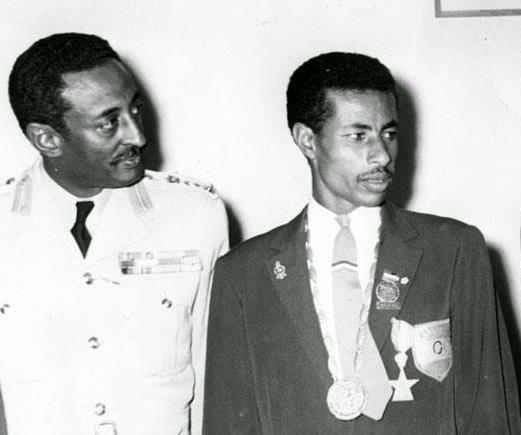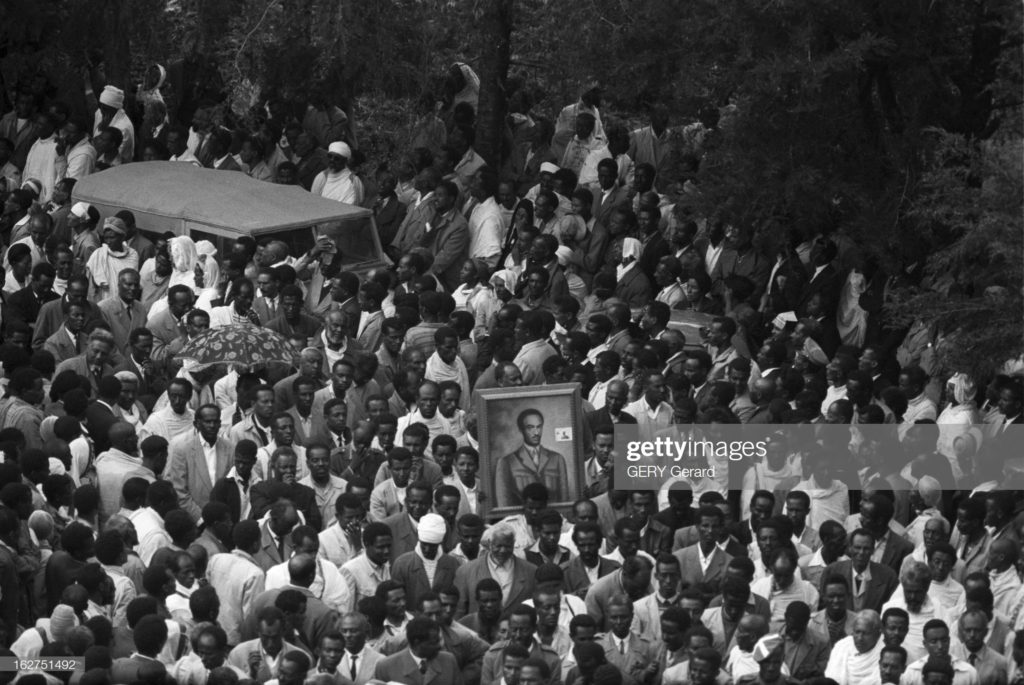Sub-Topic 3: Ethiopia: Nation Building (1930-1974)
Ethiopia is a country in north-Eastern Africa. It is one of the oldest African nations and the only one which escaped European colonialism. According to the traditions, Ethiopian emperors trace their origin to the Queen of Sheba and King Solomon of Israel. Emperors ruled Ethiopia for about 200 years. The capital city of Ethiopia is Adisaababa. The Country's total area is 1,104,302 sq.km.
The last monarch of the oligarchy was Emperor Haille Selassie (Formerly known as Ras Taffari) who came to power in 1933. He had earlier ruled as a regent of Princess Zaidutu since 1916 after the death of Emperor Menelik II.

Emperor Haile greeting Chinese Communist leader Chairman Mao Tsetung
Emperor Haile introduced a very centralised form of government. But alas, in 1935 the Italy of Mussolini invaded Ethiopia and Haile Selassie fled to Britain. Ironically, Britain recognised Italy as the ruler of Ethiopia. But when Italy joined the Second World War (in 1940) on the side of Germany, Britain swiftly recognised Haile Selassie as the Emperor of Ethiopia. Supported by Britain to the hilt, Haile Selassie organised Ethiopian forces, re-entered Ethiopia in May 1940 and routed Italian troops three months later.
THE FIRST COUP IN ETHIOPIA, I960
The aims of the abortive coup of 1960 were to transform Ethiopia into a liberal constitutional monarchy and implement much-needed social reform. The principal conspirators were Brigadier-General Mengistu Neway, commander of the Imperial Bodyguard, and his younger brother Girmame Neway, an enlightened provincial governor. On the evening of 13 December I960, while Haile Selassie was out of the country on a visit to Brazil, 4000 soldiers of the Imperial Guard took over key points in Addis Ababa.

The Neway brothers were soon joined by the head of the security service and the police commissioner, and they were supported by demonstrations of university students. The coup-makers proclaimed a reform government, but they failed to find general support either in the army garrisons throughout the country or among the population at large.
Inadequate planning meant that many reform-minded officers of units outside the capital were not brought into the conspiracy and consequently were undecided how to react when the news of the coup reached them.

The general population was not very politicized, and the Patriarch of the Ethiopian Church, a major bastion of the regime, issued a proclamation condemning the coup, with the intention of discouraging a popular uprising by the Amhara. The coup therefore took the form of a revolt by the newer Western-educated groups against the traditional nobility, rather than a mass uprising. But lack of popular support soon forced the Neways to fall back on discontented members of the royal family, like the Crown Prince, and other members of the nobility.
The coup failed for four reasons. First, the bulk of the armed forces remained loyal to the Emperor. Most of the army, the territorial force and the air force mobilized against the coup. Secondly, the general population was indifferent or hostile to the coup. Thirdly, Haile Selassie courageously returned to Ethiopia and rallied loyal forces. Fourthly, the United States played a major material role in the defeat of the coup. The Americans regarded Ethiopia as being of vital strategic importance in the Red Sea region and the southern flank of the Middle East. Kagnew air base in Asmara was a major American military communications base and a centre for counter-coup air and military operations. It was at Kagnew that the Emperor landed on his return to the country, and from Kagnew that he set off for the capital with several plane-loads of troops.

The wife of the Emperor lived in comfort while their government shamefully ignored the catastrophes of famine and poverty by concealing peoples' suffering to the rest of the world.
The United States gave considerable diplomatic and military support to the 'moderate' Emperor who in his turn backed American policies in Africa.
When they were cornered by loyalist troops in the hills outside Addis Ababa, Girmame Neway shot his brother and then himself, to escape capture. Girmame died but Mengistu, though very severely wounded, lived to be put on trial for treason and to be hanged in public. The aborted coup of I960 was an attempted reform coup.

When cross-examined in court and asked why he acted as he did, Mengistu replied: "It was necessary to do something to improve the standard of living, not only of the soldiers, but of the whole population. That was my aim.'
THE SECOND COUP IN ETHIOPIA, 1974
The causes of the successful military coup of 1974 were: the general political, social and economic backwardness of Ethiopia; an economic crisis; a famine; and the Eritrean War.
The growing numbers of Western-educated professional people, students and workers had by 1974 given up hope of any meaningful political, economic and social change while the Emperor was alive. The government continued to be a royal autocracy, assisted by a powerless parliament, and was characterized by favouritism, nepotism and financial corruption. Feudalism still existed in many parts of Ethiopia, especially in the south, where a reform of land tenure and local government was long overdue.
The economic crisis of the early 1970s seemed beyond the power or the will of the government to solve. Inflation, the reflection of international economic trends, and unemployment, the result of a stagnant economy, hit both the middle class and the working class in the cities, and also provoked a wave of discontent at low pay and poor living conditions among the lower ranks of the army.
The famine of 1972 to 1974 killed an estimated 200 000 peasants, mainly in the Wollo, Tigre, Shoa and Gondar regions, while the government shamefully first ignored the catastrophe and later tried to conceal it. The regime's response to the famine aroused deep anger and a profound sense of national shame among civilians and soldiers alike.
The Eritrean secessionist struggle had gained considerable territory in the northern Red Sea province as well as diplomatic recognition and material aid from a number of states. The Eritrean Christians were being won over to a hitherto Muslim-dominated movement whose forces were now pushing the government's troops into the towns. Many armed officers were coming to believe that a political, not a military, solution of the war was necessary and that a change of regime in Addis Ababa would be an essential pre-condition of political settlement with the Eritreans. Low morale and desertion were common among the lower ranks compelled to fight under extreme hardship against an elusive guerilla enemy in inhospitable desert and semi-desert hills.
In the middle months of 1974, military discontent (low pay, poor housing and poor living conditions, the Eritrean War) coincided with a wave of protest among politically a serious civilians to form a spontaneous and uncoordinated revolt against the regime. For several months a gradual 'creeping' coup took place, until government authority collapsed and the army took over to fill the power vacuum. Professional people, students and workers waged a militant campaign of strikes, demonstrations and acts of civil disobedience in the towns, while peasants rose against their landlords in many parts of the south. Simultaneous mutinies in the armed forces occurred, with the initiative being taken by lower soldiers and NCOs of peasant origin. Junior officers quickly joined in and took control of the mutinies, by-passing the military hierarchy. A co-ordinating committee of the armed forces, dubbed the 'Dergue' ('Committee' in Amharic) was set up; its membership of about 120 ranged in rank from private to major. The Dergue gradually attuned itself to the radical mood of the civilians and used its military strength to assume the leadership of the assault on the imperial regime:
:max_bytes(150000):strip_icc()/emperor-of-ethiopia-haile-selassie-591736334-5c53447046e0fb00012b97dc.jpg)
A series of calculated steps in the reduction of imperial power led to the Dergue deposing Haile Selassie on 12 September 1974. He had been Emperor for 44 years and the effective ruler of Ethiopia since 1916; his failure to transform the institutions of the monarchical government or to alter radically its aims led to the destruction of the ancient dynasty.
Haile Selassie died as a prisoner in mysterious circumstances in the year after he was deposed; millions of dollars' worth of gold bullion and jewellery that he 'had misappropriated from government revenue over the long period of his reign remained locked away in the vaults of Swiss and other foreign banks."
After the Emperor was deposed the Dergue transformed into a Provisional Military Advisory Council (PMAC) and imposed a military dictatorship, to the alarm of the civilian revolutionaries. Even then, the "creeping coup' had not thrown up a clear source of governmental authority.

Power struggles in the PMAC and a policy dispute over the Eritrean issue led in November to the elimination of the first head of the PMAC, the outsider and figurehead General, Aman Andom, and the emergence of Major Mengistu Haile Mariam as the real leader of the Council and of Ethiopia. Mengistu later eliminated the second figurehead leader of the PMAC, General Teferi Bante. At about the same time as Aman Andom was removed, over fifty senior officials of Haile Selassie's regime were taken from their prison cells and summarily executed by firing squad without trial. Mengistu was determined that his reform coup would not be undone by a counter-revolution carried out by the leading personalities of the old regime.
National Movements and New States in Africa